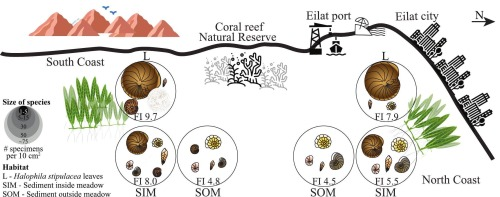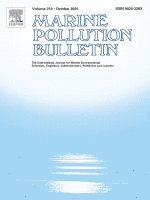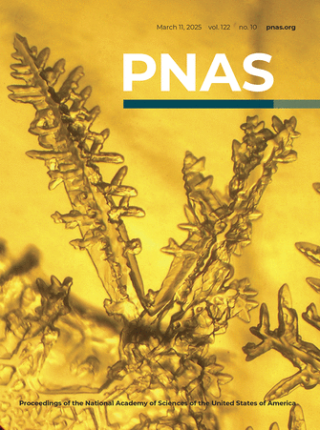-
6 Aug 2025 • Journal Article • Nature Communications
Ocean freshening near the end of the Mesozoic
AbstractPaleogeographic changes have significantly shaped ocean circulation and climate dynamics throughout Earth’s history. This study integrates geological proxies with climate simulations to assess how ocean gateway evolution influenced ocean salinity near the end of the Mesozoic (~66 Ma). Our modeling results demonstrate that 1) Central American Seaway shoaling
… show more -
28 Jul 2025 • Journal Article • Marine Pollution Bulletin
Seagrass as a stabilizing environment for benthic foraminifera living in anthropogenically impacted coastal areas
AbstractIn tropical regions, seagrass meadows provide a unique habitat for benthic foraminifera, both serving as important ecosystem engineers and sensitive indicators of coastal marine ecosystems. However, their interactions remain poorly understood, particularly in the context of anthropogenic pressures and climate change. This study investigates benthic foraminiferal
… show more
-
27 Feb 2025 • Journal Article • PNAS
A cosmopolitan calcifying benthic foraminifera in agglutinated disguise as a geochemical recorder of coastal environments
AbstractCalcifying foraminifera from the orders Rotaliida and Miliolida are widely used as geochemical proxies for recording paleoceanographic conditions, while agglutinated foraminifera are often overlooked since their tests are mostly composed of foreign particles. This study investigated the geochemical properties of Textularia agglutinans, a cosmopolitan agglutinated benthic
… show more -
1 Oct 2024 • Journal Article • Science of The Total Environment
A dynamic subtropical coastal hotspot of benthic foraminifera in the Southeastern Mediterranean indicates early-stage tropicalization
AbstractDue to ongoing ocean warming, subtropical environments are becoming accessible to tropical species. Among these environments are the vermetid reefs of the Southeastern Mediterranean (SEM). In the last decades, these valuable coastal habitats witnessed the proliferation of numerous alien species of tropical origin. Among the meiofauna thriving on these reefs are benthic
… show more
-
Apr 2024 • Journal Article • Marine Environmental Research
A matter of choice: Understanding the interactions between epiphytic foraminifera and their seagrass host Halophila stipulacea
AbstractIn sub/tropical waters, benthic foraminifera are among the most abundant epiphytic organisms inhabiting seagrass meadows. This study explored the nature of the association between foraminifera and the tropical seagrass species H. stipulacea, aiming to determine whether these interactions are facilitative or random. For this, we performed a "choice" experiment, where
… show more
-
Jan 2023 • Journal Article • Cretaceous Research
Trends in organic matter deposition in the Cretaceous of the eastern Mediterranean: Revisiting and updating the chronology and facies of the Eratosthenes Seamount deposits
AbstractIn this study we revisited the Cretaceous of the Eratosthenes Seamount (ESM) from IODP LEG 160 Hole 967E, updating the chronology, depositional environment, and paleobathymetry of the ESM. Our goal was also to address the spatio-temporal distribution of organic matter and, by comparison with the eastern margins of the Levant Basin, discuss basin-wide controls on its
… show more -
1 Feb 2022 • Journal Article • Science of The Total Environment
The combined effects of rising temperature and salinity may halt the future proliferation of symbiont-bearing foraminifera as ecosystem engineers
AbstractRising sea surface temperatures and extreme heat waves are affecting symbiont-bearing tropical calcifiers such as corals and Large Benthic Foraminifera (LBF). In many ecosystems, parallel to warming, global change unleashes a host of additional changes to the marine environment, and the combined effect of such multiple stressors may be far greater than those of temperature
… show more -
Dec 2021 • Journal Article • Functional Ecology
The transcriptomic signature of cold and heat stress in benthic foraminifera—Implications for range expansions of marine calcifiers
AbstractGlobal warming permits range expansions of tropical marine species into mid-latitude habitats, where they are, however, faced with cold winter temperatures. Therefore, tolerance to cold temperatures may be the key adaptation controlling zonal range expansion in tropical marine species. Here we investigated the molecular and physiological response to cold and heat stress
… show more -
Jun 2021 • Journal Article • Marine Micropaleontology
Unravelling the evolution of extraordinary long-range planktonic foraminifera species based on image processing analysis
AbstractThe recent growing interest in Late Cretaceous biserial planktonic foraminifera (heterohelicids) has greatly enhanced their use as paleoceanographic and biostratigraphic markers. Pseudotextularia nuttalli, one of the most common cosmopolitan planktonic foraminifera, has an exceptionally long evolutionary range (Turonian-Maastrichtian). The image processing procedure we
… show more -
Jan 2021 • Journal Article • Global and Planetary Change
Resilience of primary and export productivity in a eutrophic ecosystem following the Cretaceous-Paleogene mass extinction
AbstractThe recovery time of marine productivity following the Cretaceous-Paleogene (KPg) mass extinction varies tremendously with location (hundreds to millions of years), with possible delays in the tropics as compared to higher latitudes. This heterogeneity is based on prevalent oligo- to mesotrophic marine environments. While highly productive eutrophic environments are
… show more















